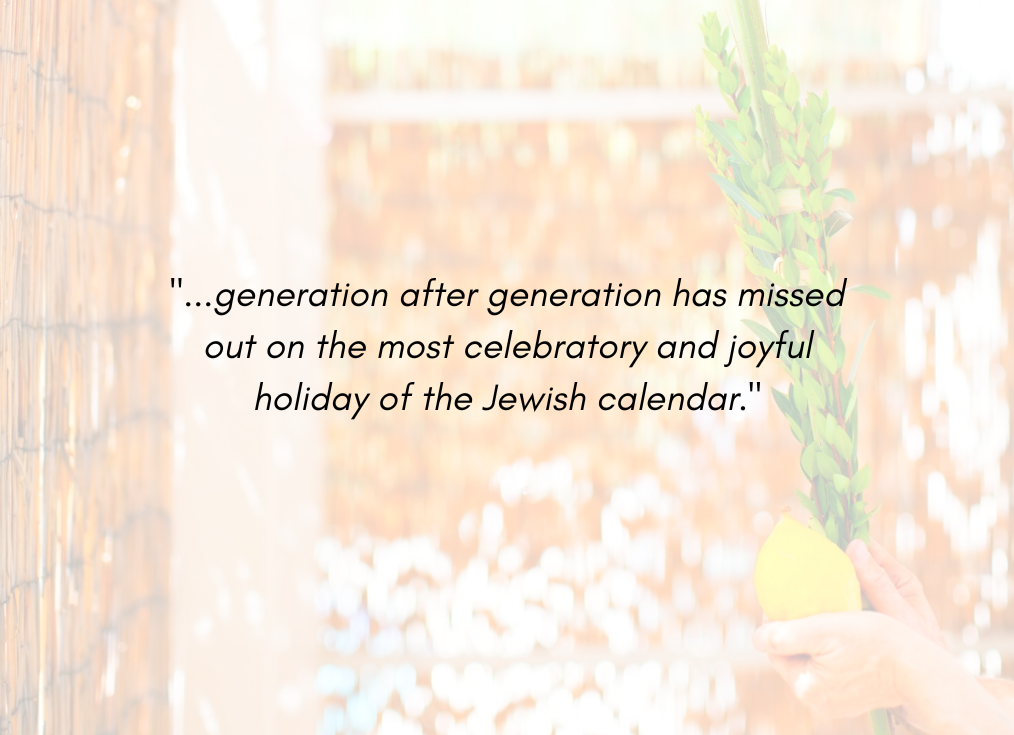The Chag

October 14, 2022 / 19 Tishrei 5783
First, chag sameach!
Second, a word or two about the holiday of Sukkot. Did you know that although many Jews can identify a relevant symbol or artifact connected to this holiday, and others may even be able to mention a related anecdote or two, the research shows that Sukkot is often one of the most overlooked holidays on the Jewish calendar?
Let’s start with its name. Whether we call it the holiday of Sukkot (“Booths” or more technically “Tabernacles”), or Chag HaAsif (“The Holiday of Ingathering”), or Zman Simchateinu (“The Time of our Rejoicing”), the fact is that like the many one-name artists who transcend a second name, this holiday is known as Chag (The “Holiday”), needing no descriptor to elaborate on its importance in our Jewish tradition.
How about the holiday’s timing? Following Rosh Hashanah and Yom Kippur, most non-observant Jews are ready to go back to their daily routines. The last thing on many secular Jews’ minds is to consider commemorating another holiday after the intense soul-searching and self-reflection of the Rosh Hashanah and Yom Kippur period.
And what about the ritual items needed to celebrate the holiday? Unlike the Shabbat candles, Hannukah menorah, or even Passover Seder Plate, the ritual items for this holiday need to be pre-ordered (where does one find a local lulav and etrog for sale?). In other words, while still in the midst of the High Holy Days, one has to start considering the necessary materials and plan how to get the sukkah built in time for this next holiday’s first evening.
The terrible irony of most Jews’ religious education is that because of the intensity leading up to the High Holy Days, Sukkot is barely taught, and if it is, there is little support in the home to celebrate the holiday, so much so that generation after generation has missed out on the most celebratory and joyful holiday of the Jewish calendar.
It is said that Eskimos have as many as seventy different words to describe “snow,” and even those who more conservatively estimate the number at fiftyish still acknowledge the incredible diversity and nuance of this critical asset to the Eskimo people. Hebrew, on the other hand, is incredibly limited with its synonyms. Every word is so very particular that few words describe the same thing. However, when it comes to “happiness,” our rabbis and linguistic scholars have identified as many as ten words to describe this not-so-stereo-typical Jewish emotion.
As I have shared in many previous columns, Judaism is very much about balance and equity, and the obligation to rejoice and be happy is no different. As counterintuitive as it might seem, we would not appreciate or even understand happiness if not for sorrow and despair, and if not for the weight and gravity of our Ten Days of Awe between Rosh Hashanah and Yom Kippur we probably would not appreciate the abundant joy of Sukkot.
So, with only a few days of the holiday remaining this year, grab a friend, pick up some snacks (preferably kosher), and visit your nearest sukkah to celebrate the holiday and fulfill the associated mitzvahs. They are not only simple to learn and quick to fulfill they also involve eating and socializing with friends and family. What could be better? Because we are…
Shabbat Shalom,

